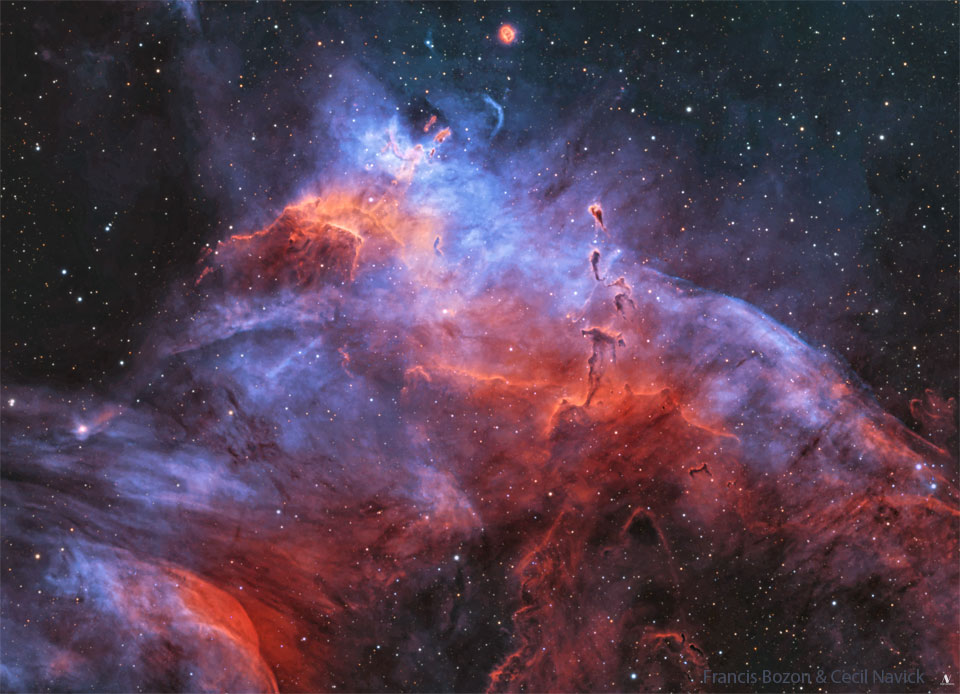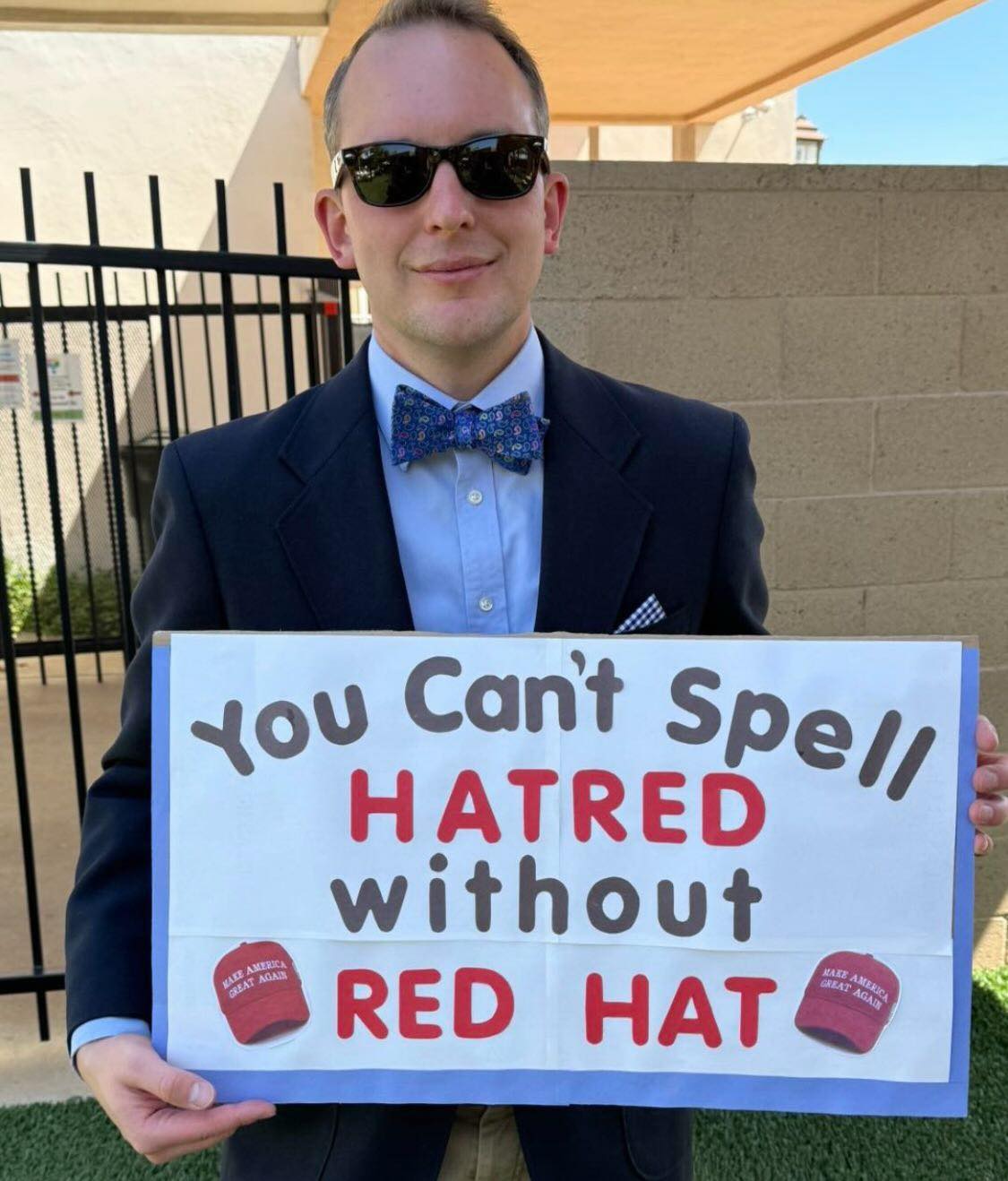Blog
This cosmic skyscape features glowing gas and dark dust clouds alongside the young stars of NGC 3572. A beautiful emission nebula and star cluster, it sails far southern skies within the nautical constellation Carina. Stars from NGC 3572 are toward top center in the telescopic frame that would measure about 100 light-years across at the cluster’s estimated distance of 9,000 light-years. The visible interstellar gas and dust, shown in colors of the Hubble palette, is part of the star cluster’s natal molecular cloud, itself cataloged as Gum 37. Dense streamers of material within the nebula, eroded by stellar winds and radiation, clearly trail away from the energetic young stars. They are likely sites of ongoing star formation with shapes reminiscent of the Tadpoles of IC 410 — better known to northern skygazers. In the coming tens to hundreds of millions of years, gas and stars in the cluster will be dispersed though, by gravitational tides and by violent supernova explosions that end the short lives of the massive cluster stars.

George Rufus Adams (April 29, 1940 – November 14, 1992) was an American jazzmusician who played tenor saxophone, flute and bass clarinet. He is best known for his work with Charles Mingus, Gil Evans, Roy Haynes and in the quartet he co-led with pianist Don Pullen, featuring bassist Cameron Brown and drummer Dannie Richmond. He was also known for his idiosyncratic singing.
more...Willie Hugh Nelson (born April 29, 1933) is an American singer, guitarist and songwriter. He was one of the main figures of the outlaw country subgenre that developed in the late 1960s as a reaction to the conservative restrictions of the Nashville sound. The critical success of his album Shotgun Willie (1973), combined with the critical and commercial success of Red Headed Stranger (1975) and Stardust(1978), made Nelson one of the most recognized artists in country music. Nelson has acted in over 30 films, co-authored several books, and has been involved in activism for the use of biofuels and the legalization of marijuana.
Nelson wrote his first song at age seven and joined his first band at ten. During high school, he toured locally with the Bohemian Polka as their lead singer and guitar player. After graduating from high school in 1950, he joined the U.S. Air Force but was later discharged due to back problems. After his return, Nelson attended Baylor University for two years but dropped out because he was succeeding in music. He worked as a disc jockey at radio stations in his native Texas, and at several radio stations in the Pacific Northwest, all the while working as a singer and songwriter throughout the late 1950s. During that time, he wrote songs that would become country standards, including “Funny How Time Slips Away“, “Hello Walls“, “Pretty Paper“, and “Crazy“. In 1960 he moved to Nashville, Tennessee, and later signed a publishing contract with Pamper Music which allowed him to join Ray Price’s band as a bassist. In 1962, he recorded his first album, …And Then I Wrote. Due to this success, Nelson signed in 1964 with RCA Victor and joined the Grand Ole Opry the following year. After mid-chart hits in the late 1960s and the early 1970s, Nelson grew weary of the corporate Nashville music scene, and in 1972 he moved to Austin, Texas. The ongoing music scene of Austin motivated Nelson to return to performing, appearing frequently at the Armadillo World Headquarters.
In 1973, after signing with Atlantic Records, Nelson turned to outlaw country, including albums such as Shotgun Willie and Phases and Stages. In 1975, he switched to Columbia Records, where he recorded the critically acclaimed album Red Headed Stranger. The same year, he recorded another outlaw country album, Wanted! The Outlaws, along with Waylon Jennings, Jessi Colter, and Tompall Glaser. During the mid-1980s, while creating hit albums like Honeysuckle Rose and recording hit songs like “On the Road Again“, “To All the Girls I’ve Loved Before“, and “Pancho and Lefty“, he joined the country supergroup The Highwaymen, along with fellow singers Johnny Cash, Waylon Jennings, and Kris Kristofferson. In 1985, he helped organize the first Farm Aid concert to benefit American farmers; the concerts have been held annually ever since and Nelson has been a fixture, appearing at every one.
In 1990, Nelson’s assets were seized by the Internal Revenue Service, which claimed that he owed $32 million. The difficulty of paying his outstanding debt was aggravated by weak investments he had made during the 1980s. In 1992, Nelson released The IRS Tapes: Who’ll Buy My Memories?; the profits of the double album—destined to the IRS—and the auction of Nelson’s assets cleared his debt. During the 1990s and 2000s, Nelson continued touring extensively and released albums every year. Reviews ranged from positive to mixed. He explored genres such as reggae, blues, jazz, and folk.
Nelson made his first movie appearance in the 1979 film The Electric Horseman, followed by other appearances in movies and on television. Nelson is a major liberal activist and the co-chair of the advisory board of the National Organization for the Reform of Marijuana Laws (NORML), which is in favor of marijuana legalization. On the environmental front, Nelson owns the biodiesel brand Willie Nelson Biodiesel, whose product is made from vegetable oil. Nelson is also the honorary chairman of the advisory board of the Texas Music Project, the official music charity of the state of Texas.
more...Raymundo “Ray” Barretto Pagán (April 29, 1929 – February 17, 2006) was an American percussionist and bandleader of Puerto Rican descent. Throughout his career as a percussionist, he played a wide variety of Latin music styles, as well as Latin jazz. His first hit, “El Watusi”, was recorded by his Charanga Moderna in 1962, becoming the most successful pachanga song in the United States. In the late 1960s, Barretto became one of the leading exponents of boogaloo and what would later be known as salsa. Nonetheless, many of Barretto’s recordings would remain rooted in more traditional genres such as son cubano. A master of the descarga (improvised jam session), Barretto was a long-time member of the Fania All-Stars. His success continued into the 1970s with songs such as “Cocinando” and “Indestructible”. His last album for Fania Records, Soy dichoso, was released in 1990. He then formed the New World Spirit jazz ensemble and continued to tour and record until his death in 2006. He is the father of American vocalist and saxophonist Chris Barretto, best known for his work with Periphery and Monuments.
more...Jean-Baptiste Frédéric Isidor, Baron Thielemans (29 April 1922 – 22 August 2016), known professionally as Toots Thielemans ([tuts tiləmans]), was a Belgian jazzmusician. He was mostly known for playing the chromatic harmonica, as well as his guitar and whistling skills, and composing. According to jazz historian Ted Gioia, his most important contribution was in “championing the humble harmonica”, which Thielemans made into a “legitimate voice in jazz”. He eventually became the “preeminent” jazz harmonica player.
His first professional performances were with Benny Goodman‘s band when they toured Europe in 1949 and 1950. He emigrated to the U.S. in 1951, becoming a citizen in 1957. From 1953 to 1959 he played with George Shearing, and then led his own groups on tours in the U.S. and Europe. In 1961 he recorded and performed live one of his own compositions, “Bluesette“, which featured him playing guitar and whistling. In the 1970s and 1980s, he continued touring and recording, appearing with musicians such as Oscar Peterson, Elis Regina, Caetano Veloso, Ella Fitzgerald, Ivan Lins, Sarah Vaughan, Bill Evans, Dizzy Gillespie, Kenny Werner, Pat Metheny, Jaco Pastorius, Mina Mazzini, Elis Regina, Quincy Jones, George Shearing, Natalie Cole, Billy Joel, Paul Simon, and Paquito D’Rivera.
Thielemans recorded the soundtracks for The Pawnbroker (1964), The Reivers (1969), Midnight Cowboy (1969), The Getaway (1972), Cinderella Liberty (1973), The Sugarland Express (1974) and Looking for Mr. Goodbar (1977). His harmonica theme song for the popular Sesame Street TV show was heard for 40 years. He often performed and recorded with Quincy Jones, who once called him “one of the greatest musicians of our time.” In 2009 he was designated a Jazz Master by the National Endowment for the Arts, the highest honor for a jazz musician in the United States.
more...Edward Kennedy “Duke” Ellington (April 29, 1899 – May 24, 1974) was an American jazz pianist, composer, and leader of his eponymous jazz orchestra from 1924 through the rest of his life.
Born and raised in Washington, D.C., Ellington was based in New York City from the mid-1920s and gained a national profile through his orchestra’s appearances at the Cotton Club in Harlem. A master at writing miniatures for the three-minute 78 rpm recording format, Ellington wrote or collaborated on more than one thousand compositions; his extensive body of work is the largest recorded personal jazz legacy, and many of his pieces have become standards. He also recorded songs written by his bandsmen, such as Juan Tizol‘s “Caravan“, which brought a Spanish tinge to big band jazz.
At the end of the 1930s, Ellington began a nearly thirty five-year collaboration with composer-arranger-pianist Billy Strayhorn, whom he called his writing and arranging companion. With Strayhorn, he composed multiple extended compositions, or suites, as well as many short pieces. For a few years at the beginning of Strayhorn’s involvement, Ellington’s orchestra featured bassist Jimmy Blanton and tenor saxophonist Ben Webster and reached what many claim to be a creative peak for the group. Some years later following a low-profile period, an appearance by Ellington and his orchestra at the Newport Jazz Festival in July 1956 led to a major revival and regular world tours. Ellington recorded for most American record companies of his era, performed in and scored several films, and composed a handful of stage musicals.
Although a pivotal figure in the history of jazz, in the opinion of Gunther Schuller and Barry Kernfeld, “the most significant composer of the genre”, Ellington himself embraced the phrase “beyond category”, considering it a liberating principle, and referring to his music as part of the more general category of American Music.Ellington was known for his inventive use of the orchestra, or big band, as well as for his eloquence and charisma. He was awarded a posthumous Pulitzer Prize Special Awardfor music in 1999.
more...Oliver Jackson (April 28, 1933 – May 29, 1994), also known as Bops Junior,was an American jazz drummer.
Jackson was born in Detroit, Michigan, United States, where he played in the 1940s with Thad Jones, Tommy Flanagan, and Wardell Gray, and had a variety show with Eddie Locke called Bop & Locke. After working with Yusef Lateef from 1954 until 1956, he moved to New York, where he played regularly at the Metropole in 1957 and 1958. Following this he worked with Teddy Wilson, Charlie Shavers (1959–61), Buck Clayton, Benny Goodman (1962), Lionel Hampton (1962–64), Kenny Burrell, Earl Hines(1964–70 intermittently) and the JPJ Quartet with Budd Johnson. Later in life he played with Sy Oliver (1975–80), Oscar Peterson, and George Wein‘s Newport All-Stars. As a bandleader, Jackson led a 1961 date in Switzerland, and recorded at least five albums for Black & Blue Records between 1977 and 1984.
more...A beautiful but skewed spiral galaxy dazzles in today’s NASA/ESA Hubble Space Telescope Picture of the Week. This galaxy, called Arp 184 or NGC 1961, sits about 190 million light-years away from Earth in the constellation Camelopardalis (The Giraffe).
The name Arp 184 comes from the Atlas of Peculiar Galaxies, which was compiled by astronomer Halton Arp in 1966. The 338 galaxies in the atlas are oddly shaped, tending to be neither entirely elliptical nor entirely spiral-shaped. Many of the galaxies are in the process of interacting with other galaxies, while others are dwarf galaxieswithout well-defined structures. Arp 184 earned its spot in the catalogue thanks to its single broad, star-speckled spiral arm that appears to stretch toward us. The galaxy’s far side sports a few wisps of gas and stars but lacks a similarly impressive spiral arm.
This Hubble image combines data from three Snapshot observing programmes, which are composed of short observations that can be slotted into time gaps between other proposals. One of the three programmes targeted Arp 184 for its peculiar appearance. This programme surveyed galaxies listed in the Atlas of Peculiar Galaxies as well as A Catalogue of Southern Peculiar Galaxies and Associations, a similar catalogue compiled by Halton Arp and Barry Madore.
The remaining two programmes were designed to check up on the aftermath of fleeting astronomical events like supernovae and tidal disruption events — when a star is ripped apart after wandering too close to a supermassive black hole. Since Arp 184 has hosted four known supernovae in the past three decades, it’s a rich target for a supernova hunt.
[Image Description: A spiral galaxy seen at a skewed angle. Its centre is a bright spot radiating light. A thick, stormy disc of material surrounds this, with swirling strands of dark dust and bright spots of star formation strewn through the disc. A large spiral arm extends from the disc towards the viewer. Some foreground stars are visible atop the galaxy.]

more...
Charles Alfred Leavell (born April 28, 1952) is an American musician. A member of the Allman Brothers Band throughout their commercial zenith in the 1970s, he subsequently became a founding member of the band Sea Level. He has served as the principal touring keyboardist and musical director of the Rolling Stones since 1982. As a session musician, Leavell has performed on every Rolling Stones studio album released since 1983 with the exception of Bridges to Babylon (1997). He has also toured and recorded with Eric Clapton, George Harrison, David Gilmour, Gov’t Mule, Train, and John Mayer.
more...William Anthony Colón Román (born April 28, 1950) is an American and Puerto Rican Salsa musician and social activist. He began his career as a trombonist but also sings, writes, produces and acts. Colón was a pioneer of Salsa music and a best-selling artist in the genre, having been a key figure in the nascent New York City scene associated with Fania Records. He is also noteworthy for having assumed the gangster image in his album covers before it was culturally popular. Since the 1980s he has at times been deeply involved in the politics of New York City.
more...Steve Khan (born Steven Harris Cahn; April 28, 1947) is an American jazz guitarist.
Steven Harris Cahn was born in Los Angeles. His father, lyricist Sammy Cahn, “loved to hear any and all versions of his songs”. He took piano lessons as a child and played drums for the surf rock band the Chantays. The band’s guitarist exposed him to the albums Tough Talk by The Crusaders and Movin’ Wes by Wes Montgomery. In his late teens he quit the drums and started playing guitar. He was a member of the R&B band Friends of Distinction, recorded with keyboardist Phil Moore, then played on the album Bullitt by Wilton Felder (“one of my heroes”). Despite his father’s advice to avoid a career in the music business, he graduated from UCLA with a degree in music composition and theory. Early in his career, Khan changed the spelling of his surname in order to “create a separate identity from [his] famous father” and because he was “so hurt and angry with him for so many childhood things.”
In the early 1970s, he performed in an acoustic guitar duo with Larry Coryell and was a member of the Brecker Brothers band. As a session musician, he appeared on albums by Ashford & Simpson, Rupert Holmes, Billy Joel, and Steely Dan. He was signed to Columbia Records through the efforts of Bobby Colomby and Bob James. On his first three albums Tightrope (1977), The Blue Man (1978), and Arrows (1979), he was trying “to single-handledly keep alive the sound of the original Brecker Brothers band.” His next album was Evidence (1980), which contained an eighteen-minute medley of songs by Thelonious Monk.
more...Prudencio Mario Bauzá Cárdenas (April 28, 1911 – July 11, 1993) was an Afro-Cuban jazz, and jazz musician. He was among the first to introduce Cuban music to the United States by bringing Cuban musical styles to the New York City jazz scene. While Cuban bands had had popular jazz tunes in their repertoire for years, Bauzá’s composition “Tangá” was the first piece to blend jazz harmony and arranging technique, with jazz soloists and Afro-Cuban rhythms. It is considered the first true Afro-Cuban jazz tune.
more...


